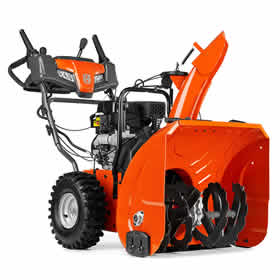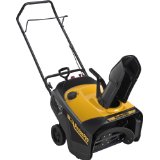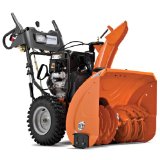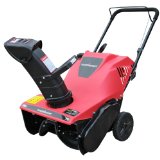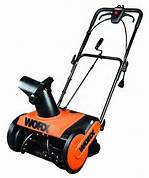Snow Blowers Make Removing Snow Easy!
Introduction
Choosing the right snow blower depends upon various factors, which includes your specific needs, size of property and the typical snow conditions in your area. There are two main types of snow blowers, single-stage and two-stage, which cater to different needs.
Gas-powered models offer more power for larger areas, while electric ones are more convenient but better suited to smaller spaces. Don’t forget to factor in the clearing width, engine power, and drive system for optimal performance.
Adjustable chute controls and a reliable start mechanism enhance user experience. The auger design, wheel or track options, and ease of storage help to contribute to the decision-making process.
Be sure to research the brand reputation, read reviews, and prioritize the warranty information and customer support for a well-informed purchase before buying.
Key Considerations for Snow Blowers
Below we mention some of the key considerations to look for when buying a snow blower.
Types of Snow Blower
-
Single-Stage Snow Blowers
- Usage: This is ideal for light to moderate snowfalls up to 6 inches.
- Design: Single-stage snow blowers have an auger that spins to both scoop up and throw the snow in one motion.
- Performance: These snow blowers are more lightweight, compact, and easy to maneuver, making them suitable for smaller driveways and walkways.
- Clearing Width: Typically, they have a narrower clearing width when compared to two-stage models.
- Best for: These snow blowers are best for area with frequent but not heavy snowfall, and where maneuverability is a priority.
2. Two-Stage Snow Blowers
- Usage: These snow blowers are suited for larger areas and heavy snowfalls.
- Design: These snow blowers have an auger to gather the snow and a separate impeller to discharge it. It allows them to handle larger volumes and heavier snow.
- Performance: They are more powerful and efficient, making them suitable for deep snow and tough conditions.
- Clearing Width: These models offer a wider clearing width, allowing for quicker snow removal on larger surfaces.
- Best for: These models are best for areas with large driveways, heavy and wet snow, or regions that are prone to significant snow accumulations in the winter.
Choosing between single-stage and two-stage snow blowers depends on factors like the amount and type of snow you typically receive in winter, the size of the area you need to clear, and your preferences for ease of use and maneuverability.
Power Source
Snow blowers come in various power sources, each with its own advantages and considerations. Below is more information about the two main types:
Gas-Powered Snow Blowers
Pros:
- Power: Gas models typically offer more power and are well-suited for heavy snowfalls and large clearing areas.
- Portability: No power cords, providing greater mobility and freedom of movement.
- Auger Control: Some models have adjustable auger heights, allowing for better performance on uneven surfaces.
- Run Time: Unlimited run time as long as there is fuel in the tank.
Cons:
- Maintenance: These models require regular maintenance, which includes oil changes, fuel stabilizers, filter changes, and tune-ups.
- Emissions and Noise: Produces emissions and is generally louder than electric and battery powered models.
- Start-up Difficulty: Pull-start engines may be challenging in extremely cold weather.
Electric Snow Blowers
- Pros:
- Low Maintenance: Electric and battery powered models are generally low maintenance when compared to the gas-powered models.
- Environmentally Friendly: They have zero emissions during operation, making them more environmentally friendly.
- Ease of Use: Electric start is convenient, and there is no need to deal with gas, oil and a pull cord.
- Cons:
- Cord Limitation: Corded models are limited by the length of the power cord, available electrical outlets, which may restrict movement and how much snow can be cleared. The cord may get damaged and must be replaced.
- Battery Life: Cordless models are limited by its battery life. This requires you to recharge it for prolonged use to finish the snow clearing job.
- Power Limitations: May be less powerful than gas models, making them better suited for lighter snowfall and smaller clearing areas.
When choosing between gas and electric snow blowers, consider the size of your property to be cleared, the typical snow conditions, maintenance preferences, and the level of power you need.
Gas-powered models are better for larger clearing areas with heavy snow, while electric and battery powered models are often more convenient for smaller clearing spaces with lighter snowfall.
Clearing Width and Intake Height
All snow blower types have a limit of how much snow by height they can intake and how wide they clear in one pass. You need to consider the size of your driveway or walkway to determine these features. A wider clearing width means you can clear more snow in each pass, but it may be harder to maneuver in tight spaces. A higher intake height means you can clear more snow in deeper storms.
Snow blowers’ costs will be determined by its intake height and clearing width. Select a snow blower that meets your needs as well as your budget.
Engine Power
For gas-powered models, you need to consider the engine’s horsepower or cubic centimeters (cc). A higher power is generally better for handling heavy or wet snow.
Battery powered and corded models generally do not work well in heavy or wet snow. They have a tendency of the motor to burn out or it puts a strain on the battery causing it to lose runtime.
Electrical models use a cord for clearing snow. They are limited to the length of the cord and electrical outlets available for use.
Battery powered models are limited to the amount of charge they hold for clearing snow. Most models average between 30 to 45 minutes before they need to be re-charged.
If you live in an area that get lots of snowfall in winter, a gas-powered model is best.
Drive system
Most two-stage snow blowers often have a self-propelled drive system which makes them easier to maneuver, especially in deep snow. They also come with a hydrostatic or friction drive options. The main differences between them are hydrostatic drive system snow blowers allows the operator to change the drive speed of the snow blower by simply moving the lever forward or backward while the unit is still moving, and the friction drive models requires the unit to come to a complete stop before shifting to another speed. You need to determine which one is best for your needs.
Chute Control
When looking for a snow blower, look for a model with adjustable chute direction and deflector. These features allow you to control where the snow is thrown, preventing it from piling up in unwanted areas around your house. Some models have cranks that allows you to move the chute without stopping. Some model snow blowers have manual chutes for you to adjust when stopped.
Start Mechanism
There are two basic types of start mechanisms, and they are pull-start and electric start. Electric start is more convenient than pull-start, especially in cold weather. Some higher-end models may offer both options. Select the start option that is best for your area.
Auger Design
The primary difference between a single-stage auger and a dual-stage (two-stage) auger lies in their design and functionality. These components play a crucial role in how a snow blower collects and processes snow for removal.
-
Single-Stage Auger
- Design: A single-stage snow blower has a single auger, which is a helical blade that rotates to both scoop up and throw the snow in one motion.
- Functionality: The auger comes into direct contact with the ground, collecting and propelling the snow through the discharge chute.
- Best for: A single-stage snow blower is suitable for lighter snowfalls and smaller clearing areas. They are effective on paved surfaces but may struggle with uneven terrain or gravel driveways.
-
Two-Stage Auger
- Design: A two-stage snow blower has two main components—a serrated auger and an impeller. The auger scoops up the snow, and the impeller, located behind the auger, throws the snow through the discharge chute.
- Functionality: The auger does the initial work of breaking up and collecting the snow, while the impeller processes and propels the snow, allowing for greater throwing distances.
- Best for: The two-stage snow blowers are designed for heavier snowfalls and larger clearing areas. They are more powerful and can handle various snow conditions, including deep and wet snow. The auger doesn’t touch the ground, making them suitable for uneven surfaces and gravel driveways.
- Material and Design: Consider the material and design of the auger. Serrated augers or those with a non-stick coating can handle icy or wet snow better.
The key distinction is that single-stage snow blowers have a single auger that performs both snow collection and ejection, while dual-stage snow blowers have a two-part system with a separate auger and impeller. It offers greater power and efficiency, especially in challenging snow conditions. Dual-stage models are generally recommended for more substantial snow removal tasks verses single-stage models.
Wheels or Tracks
The choice between wheels and tracks on a snow blower can significantly impact its performance. This is true for maneuverability, traction, and stability in various snow conditions. Below is a breakdown of the roles and considerations for both wheels and tracks:
-
Wheels
- Maneuverability: Wheeled snow blowers are generally more maneuverable, making them easier to turn and navigate around obstacles. This is advantageous in smaller spaces or when dealing with complex driveway layouts.
- Surface Compatibility: Wheels work well on flat and paved surfaces, such as driveways and sidewalks. However, they may struggle on uneven or steep terrains, and they can slip in deep or wet snow.
- Ease of Use: Wheel-based snow blowers are typically easier to control and steer, proving a user-friendly experience.
-
Tracks
- Traction: Tracked snow blowers offer superior traction, especially in challenging conditions like deep or heavy snow. The tracks provide better stability and prevent slippage, making them well-suited for uneven or sloped terrains.
- Performance in Deep Snow: Tracks excel in deep snow, allowing the snow blower to move more effectively without getting stuck. This is particularly important in regions with frequent heavy snowfalls.
- Weight Distribution: Tracks distribute the weight of the snow blower more evenly, reducing the likelihood of sinking into soft or deep snow.
- Stability: Tracked snow blower models tend to be more stable, providing better control when operating on rough terrain.
When choosing between wheels and tracks, consider the specific conditions of your property. If you have a flat, paved driveway and prioritize maneuverability, wheels may be sufficient. However, if you deal with deep snow or have uneven terrain, tracks can offer better traction and stability, ensuring efficient snow removal in more challenging environments.
Ease of Storage
The ease of storing the snow blower is very important. When storing the snow blower, consider the size and storage requirements. Some models are foldable or have a compact design for easier storage. Two-stage models are more difficult to store than single-stage models. The reason being they are bigger and require more space. When purchasing a snow blower don’t forget to consider where it will be stored when spring comes.
Brand Reputation and Reviews
Before purchasing any snow blower, do some research about the reputation of the brand you are interested in buying. Be sure to read the reviews from other users of the product to get an idea of the reliability and performance of the snow blower. Also, go to your local shop (Ace, Home Depot, Lowes, and Menards) that sells snow blowers and you can ask questions about the brand you are interested in with the sales rep.
Warranty and Customer Support
Check the warranty that is offered by the manufacturer and the availability of customer support in case you encounter issues like parts or need assistance with the operation of the snow blower. Contact customer support and ask questions about the warranty. Ask them what is required to keep the warranty valid for the warranty coverage period, what is covered with the warranty, how to submit a warranty claim, and where the repairs are made under the warranty.
Conclusion
Choosing between single-stage and two-stage snow blowers depends on factors like the amount of snow you typically receive, the size of the area you need to clear, and your preferences for ease of use and maneuverability.
We shared some features that the snow blowers offer. Remember to match the features of the snow blower to your specific needs and the conditions in your area to ensure efficient and effective snow removal. Don’t neglect the snowfall and the terrain you have for the proper snow blower model.
There are three types of snow blowers on the market, and they are gas-powered, battery and electric cord.
With the proper snow blower model, you should have no problems in doing your own snow removal when required. Don’t forget about the storage. Be sure you have sufficient space to store the snow blower away until it’s needed the following winter.
Related Articles
Below are some other articles you might be interested in reading.
- Single Stage Electric Snow Blowers
- Single Stage Snow Blowers
- Snow Blower Stage Review
- Snow Blowers By Brands
- Two Stage Snow Blower
Go back to the Snow Blowers and More home page.
